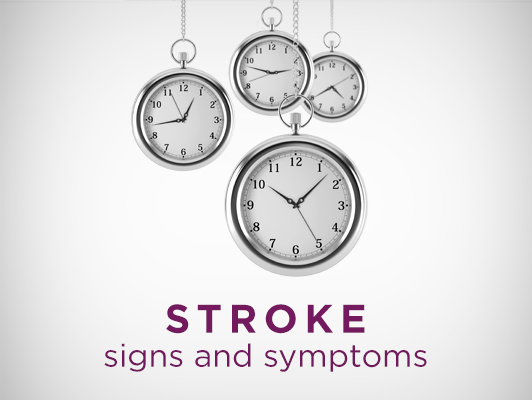Stroke signs and symptoms

A stroke occurs when the brain is deprived of blood flow. Blood flow is restricted in a stroke for one of two reasons — the vessel bursts due to weakness, or a clot blocked a portion of the vessel. Without blood flow, brain cells begin to die due to lack of oxygen. Oftentimes the death of these cells leaves permanent damage to body functions, cognition, and memory.
According to the National Stroke Association, “a stroke happens every 40 seconds.” For this reason it is imperative to know the signs and symptoms of a stroke. The acronym FAST is used to help determine if a person is having the sudden signs of a stroke.
Face — Examine the person’s face. Ask the person to smile. Drooping or numbness to one side of the face indicates a stroke.
Arm Weakness — If the person has weakness or numbness in one arm or is unable to hold both arms up without one drifting down, this indicates a stroke.
Speech Difficulty — If the person’s speech is slurred, he or she is unable to repeat a simple sentence, is unable to speak, or is difficult to understand, this indicates a stroke.
Time — If a person is experiencing any of these symptoms, call 911 immediately! If possible, note the time the symptoms began. Even if the symptoms go away, proceed with calling 911.
In addition to these symptoms, numbness to the body or extremities on one side, sudden severe headache or confusion, trouble seeing, problems with balance, coordination, or dizziness can also indicate a stroke. If you suspect someone is having a stroke, call 911 immediately.
Although a stroke can happen to anyone, there are several things that increase the risk of having a stroke, such as smoking, alcohol use, poor diet, and inactivity. Talk to a health coach if you are ready to make changes to improve your lifestyle. There are also medical conditions and genetic factors that increase the risk of a stroke. Talk to your doctor to find out if you are at risk.
Resources:
National Stroke Association. (n.d.). What is stroke? Retrieved March 16, 2016, from http://www.stroke.org/understand-stroke/what-stroke
American Heart Association/American Stroke Association. (n.d.). Retrieved March 16, 2016, from http://www.strokeassociation.org/STROKEORG/WarningSigns/Stroke-Warning-Signs-and-Symptoms_UCM_308528_SubHomePage.jsp
American Heart Association/American Stroke Association. (n.d.). Retrieved March 16, 2016, from http://www.strokeassociation.org/STROKEORG/WarningSigns/Learn-More-Stroke-Warning-Signs-and-Symptoms_UCM_451207_Article.jsp#.VunvNsv2Zdg
UPMC_16_1364


